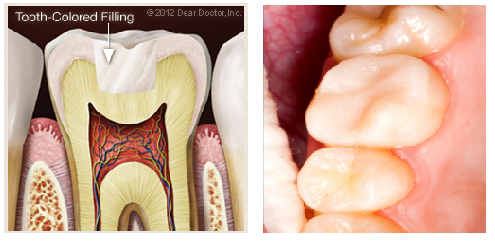Fillings
Fillings
Fillings seal a small hole in the tooth possibly caused by decay. This prevents the decay from spreading further into the tooth and , if untreated, continue on to the sensitive inner pulp (nerve) tissue located in the root canal. Should this happen, you would need a root canal.
There are a variety of materials used to fill teeth now days, but the process of filling a tooth is similar regardless. The first step is an exam of the tooth with x-rays to determine the extent of the decay. Then the decayed area of the tooth is removed usually with a handheld instrument such as a dental drill. Your tooth will be anesthetized first so you won't feel any pain. If you normally feel nervous about receiving numbing injections, it's possible that taking an anti-anxiety medication or using nitrous oxide can help you feel relaxed. After removing the decay, the remaining tooth structure is roughened or "etched" with a mildly acidic solution, then translucent cement is applied to bond the tooth and the filling material together.
Cast Gold
Among the most expensive restorative dental materials, cast gold combines gold with other metals for a very strong, long-lasting filling. This is highly noticeable, which is a plus or minus.
TOOTH-COLORED FILLINGS:

Composite
A popular choice for those who don't want their fillings to show. It's a mixture of plastic and glass, which actually bonds to the rest of the tooth. Composites are more expensive than amalgam fillings, the newer materials can hold up almost as long. Less drilling of the tooth is necessary when placing composite as compared to amalgam.
Porcelain
These high-tech dental ceramics are strong, lifelike and don't stain as composites can. They are sometimes more expensive than composites because the may require the use of a dental laboratory or specialized computer-generated technology. While considered the most aesthetic filling, they can also be brittle because of their higher glass content.
Glass Inomer
Made of acrylic and glass powders, these inexpensive, translucent filling have the advantage of blending in pretty well with the natural color of the teeth and releasing small amounts of fluoride to help prevent decay. They generally don't last as long as other restorative materials.
Expectations after a filling
The numbness cause by the local anesthesia should wear off within a few hours. Until then, it's best to avoid drinking hot or cold liquids and eating on the side of your mouth with the new filling. Some sensitivity to hot and cold is normal in the first few weeks after getting a tooth filled. If it persists beyond that time frame, or you have any actual pain when biting, it could signal that an adjustment to your fillings need to be made. Continue to brush and floss as normal every day and visit the dental office at least twice a year for your regular checkups and cleanings. And remember, tooth decay is a very preventable disease: with good oral hygiene and professional care, you can make your most recent cavity your last.
Related Articles:
Tooth-Colored Fillings Tooth Decay - A Preventable Disease Tooth Decay - How to Assess your RiskOur Facebook Feed
Privacy Policy
| Do Not Share My Information
| Conditions of Use
| Notice and Take Down Policy
| Website Accessibility Policy
© 2024
The content on this website is owned by us and our licensors. Do not copy any content (including images) without our consent.

